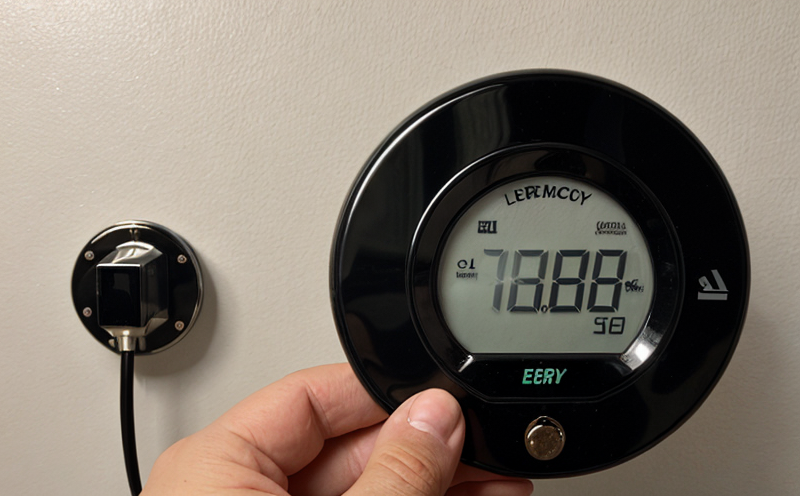BS EN 14825 Seasonal Energy Efficiency Ratio Testing
The BS EN 14825 standard is a key document that sets out the method for determining the seasonal energy efficiency ratio (SEER) of space cooling equipment. This test is critical in assessing how efficiently air conditioning units operate over an entire cooling season, taking into account variations in temperature and humidity.
The SEER rating provides consumers with valuable information on the energy consumption characteristics of cooling devices during different environmental conditions. By adhering to this standard, manufacturers can ensure their products are optimized for performance throughout varying climatic conditions, enhancing overall efficiency and reducing operational costs.
This testing method is particularly important in sectors such as electronics manufacturing where precise control over temperature and humidity levels are essential. The BS EN 14825 SEER test ensures that the components within these devices meet stringent energy-efficiency standards, thereby contributing to sustainable development goals. Compliance with this standard also helps companies meet regulatory requirements imposed by governments globally.
The process involves simulating real-world operating conditions through a series of controlled tests designed to replicate typical seasonal variations in climate. During each phase of the test, detailed measurements are taken to determine the amount of electrical energy consumed by the unit while delivering cooling capacity.
Understanding and implementing this testing protocol is crucial for maintaining high standards within the electronics industry, ensuring product reliability and performance under diverse environmental conditions. Quality managers, compliance officers, R&D engineers, and procurement teams alike must stay abreast of such developments to ensure their organizations comply with international best practices.
Scope and Methodology
| Parameter | Description |
|---|---|
| Cooling Capacity | The total amount of heat that can be removed from a space by the cooling device. |
| SEER Rating Calculation | A weighted average of the energy efficiency ratio (EER) over four test conditions representing different seasonal periods. |
| Test Duration | The entire process typically lasts several days, with multiple cycles to ensure accuracy. |
| Data Collection | Involves continuous monitoring of power consumption and cooling output using advanced instrumentation. |
The testing procedure begins by establishing the initial conditions in the test chamber. These include setting up the equipment according to specified guidelines, ensuring all components are properly connected, and verifying that the calibration standards meet current requirements.
Once the setup is complete, the actual testing commences with sequential operation under defined temperature ranges corresponding to different climatic zones worldwide. Throughout each phase, precise measurements of energy usage are recorded alongside corresponding cooling outputs.
The data collected during these tests form the basis for calculating the final SEER rating using a predefined formula. This involves averaging the EER values obtained from various stages, weighted according to their relative contributions towards overall seasonal performance.
Benefits
Adherence to BS EN 14825 standards offers numerous advantages for manufacturers and end-users alike:
- Enhanced Consumer Trust: Products carrying certified SEER ratings are perceived as more reliable and environmentally friendly.
- Regulatory Compliance: Ensures compliance with international regulations promoting energy efficiency.
- Cost Reduction: Efficient cooling systems reduce long-term operational expenses through lower electricity bills.
- Sustainability: By optimizing performance under diverse conditions, manufacturers contribute to global environmental conservation efforts.
In addition to these tangible benefits, the adoption of rigorous testing protocols like BS EN 14825 fosters innovation within the electronics sector. Manufacturers are encouraged to explore new technologies and materials that could further enhance energy efficiency without compromising functionality or durability.
Eurolab Advantages
Eurolab stands out as a premier provider of BS EN 14825 SEER testing services, offering several distinct advantages:
- Comprehensive Expertise: Our team consists of highly skilled professionals with extensive experience in this field.
- Precision Instruments: Utilizing state-of-the-art equipment ensures accurate and reliable results.
- Regulatory Knowledge: Keeping abreast of all relevant standards and updates allows us to provide accurate interpretations and applications.
- Timely Delivery: Efficient processes enable quick turnaround times, minimizing disruption for clients.
We pride ourselves on delivering top-notch services tailored specifically to meet the needs of our customers. Whether you're a small startup or an established multinational corporation, Eurolab is committed to providing exceptional quality assurance solutions.





